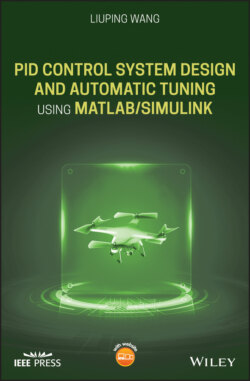Читать книгу PID Control System Design and Automatic Tuning using MATLAB/Simulink - Liuping Wang - Страница 10
Preface
ОглавлениеPID control systems are the fundamental building blocks of classical and modern control systems. They have been used in the majority of industrial applications from chemical process control, mechanical process control, electro-mechanical process control, aerial vehicle control to electrical drive control and power converter control. Understanding these control systems and having the capability to design and implement them are paramount to a control engineer.
There are several key reasons for the continuing applications of PID controllers.
1 Simplicity in the design and analysis. There are three parameters to be chosen in the control systems. These parameters are easily understood and tuned by engineers.
2 Simplicity in the implementation. Although the PID control systems are designed and analyzed in the continuous-time, implementation is performed in discrete-time with control signal limits imposed.
3 The majority of the physical systems in the electrical, mechanical, aerospace and civil engineering fields can be decomposed in terms of components of first order or second order systems. For these first order and second order systems, the PID controller is a natural candidate because of its simplicity in design and implementation. For chemical process control, a complex system is often approximated using a first order plus delay model and a PID controller is commonly used.
This book is to present learning materials for students, instructors and engineers in various fields who wish to learn design, implementation and automatic tuning of PID control systems. The book begins with the basics in PID control systems (see Chapter 1), introducing the various PID control structures and the PID controller tuning rules. Chapter 2 presents the necessary tools for closed-loop stability and performance analysis and explains the roles of sensitivity functions in relation to disturbance rejection, reference following and measurement noise attenuation. In Chapter 3, pole-assignment controller design methods are introduced for PID controllers and resonant controllers that will track a sinusoidal reference signal and reject a sinusoidal disturbance. Feedforward compensation is introduced in this chapter. Many analytical examples and two MATLAB tutorials are given in this chapter to show the details of the designs. Chapter 4 discusses how a PID controller can be implemented in real-time with the topics of discretization, integrator windup problem, anti-windup mechanisms, and other implementation issues. A MATLAB real-time function is provided for PID controller implementation with anti-windup mechanism. Chapter 5 examines the PID controller design and resonant controller design from a different angle to the previous chapters. It introduces the integral mode and resonant modes through disturbance estimation. With the disturbance observer based approaches, the implementations of these control systems naturally incorporate anti-windup mechanisms when the control signal reaches its limit. MATLAB real-time functions are provided for the implementation of the PID controller and resonant controller with anti-windup mechanisms. In Chapter 6, PID control of nonlinear systems is discussed, which includes the topics of linearization, case study of a ball and plate balancing system with experimental validation, gain scheduled PID control systems and gain scheduled disturbance observer based control systems. Chapter 7 presents cascade PID control systems with the topics of cascade control system design, its roles in disturbance rejection and overcoming actuator's nonlinearities. Chapter 8 considers PID controller design for complex systems using frequency response data, which includes the topics of PID controller design using gain and phase margins, PID controller design using two frequency points with a specification on the desired sensitivity function, and empirical rules derived for PID control of integrator with time delay systems that have a performance specification and corresponding gain and phase margin measurement. MATLAB functions are given for the computation of the PID controller parameters using two frequency response points. Chapter 9 presents automatic tuning of PID controllers using relay feedback control. MATLAB real-time functions are created for relay feedback control and used for the Simulink simulations. The Fourier analysis and frequency sampling filter model are used, as two different methods, for the estimation of plant frequency response with the data generated from relay feedback control. The auto-tuners are created by linking the estimation to the PID controllers designed in the frequency domain as presented in Chapter 8. MATLAB functions are presented in a step-by-step manner for the estimation algorithms and for the auto-tuners. As case studies, Chapter 10 applies the PID control system design and the auto-tuner to multi-rotor unmanned aerial vehicles. This chapter is supported with experimental validations.
The book is self-contained with MATLAB/Simulink tutorials and supported with simulation and experimental results. Control system simulation and experimental implementation are emphasized in the book materials. The MATLAB real-time functions written for the use in Simulink simulations could be converted into C-codes for control system implementation with micro-controllers. For each section, there is a set of questions for us to reflect on. Some of them are easy and straightforward while others may require some thinking. At the end of each chapter, there is a set of problems for practicing the design and simulation of the control systems.
The book is suited for readers who have completed first three years engineering studies with some basic knowledge in block diagrams and Laplace transforms.
Liuping Wang
Melbourne, Australia
